Abstract
OBJECTIVE: To determine the likelihood of nonsentinel axillary metastasis in the presence of sentinel node metastasis from a primary breast carcinoma. SUMMARY BACKGROUND DATA: Sentinel lymphadenectomy is a highly accurate technique for identifying axillary metastasis from a primary breast carcinoma. Our group has shown that nonsentinel axillary lymph nodes are unlikely to contain tumor cells if the axillary sentinel node is tumor-free, but as yet no study has examined the risk of nonsentinel nodal involvement when the sentinel node contains tumor cells. METHODS: Between 1991 and 1997, axillary lymphadenectomy was performed in 157 women with a tumor-involved sentinel node. Fifty-three axillae (33.5%) had at least one tumor-involved nonsentinel node. The authors analyzed the incidence of nonsentinel node involvement according to clinical and tumor characteristics. RESULTS: Only two variables had a significant impact on the likelihood of nonsentinel node metastasis: the size of the sentinel node metastasis and the size of the primary tumor. The rate of nonsentinel node involvement was 7% when the sentinel node had a micrometastasis (< or =2 mm), compared with 55% when the sentinel node had a macrometastasis (>2 mm). In addition, the rate of nonsentinel node tumor involvement increased with the size of the primary tumor. CONCLUSIONS: If a primary breast tumor is small and if sentinel node involvement is micrometastatic, then tumor cells are unlikely to be found in other axillary lymph nodes. This suggests that axillary lymph node dissection may not be necessary in patients with sentinel node micrometastases from T1/T2 lesions, or in patients with sentinel node metastases from T1a lesions.
Full text
PDF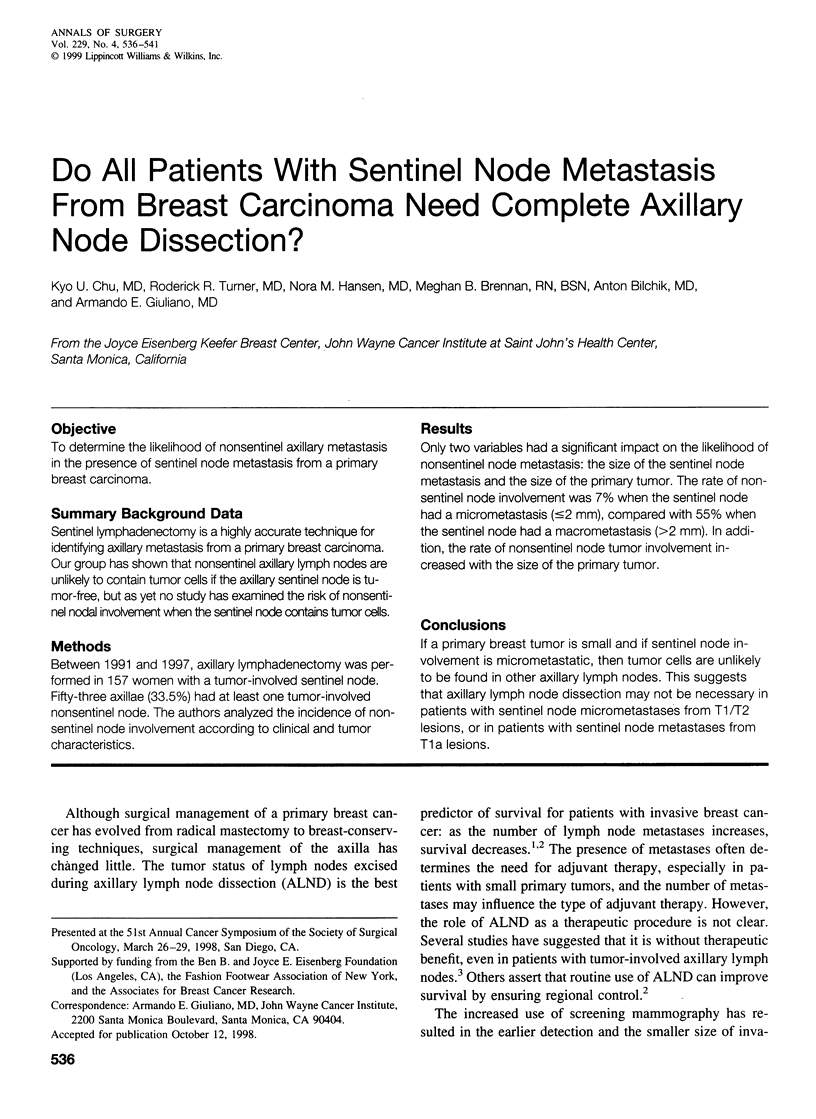
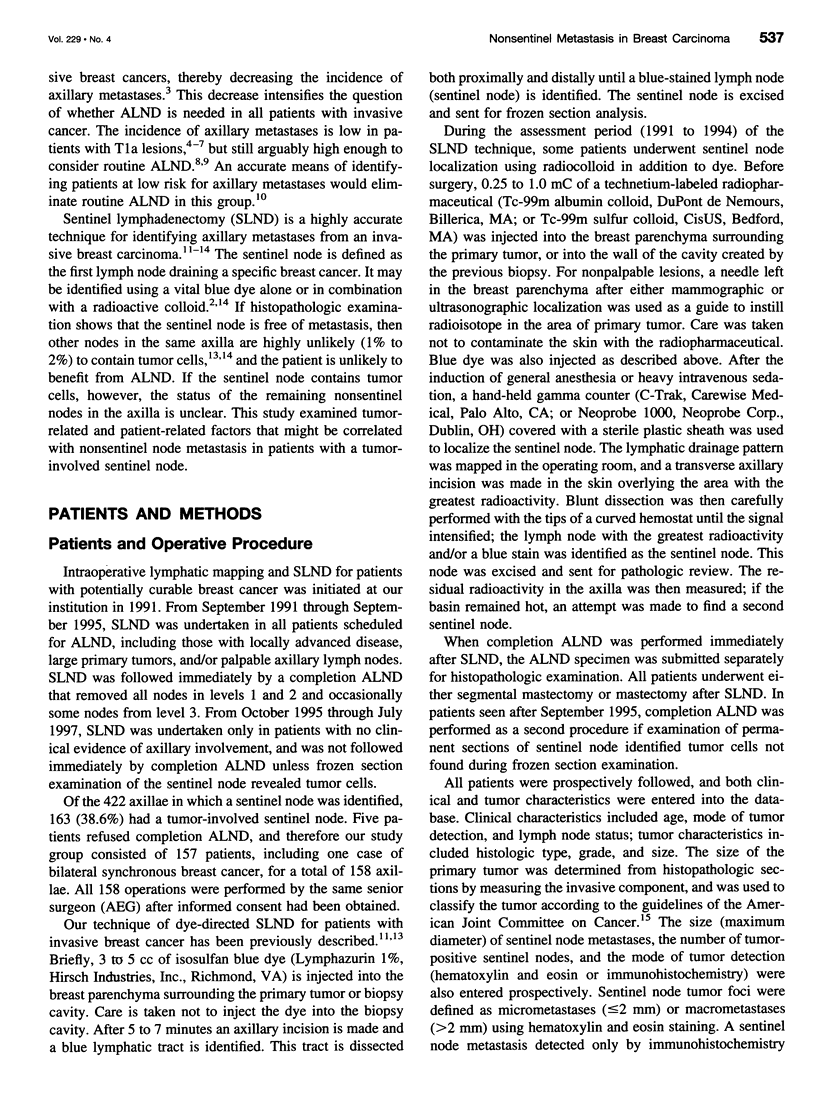
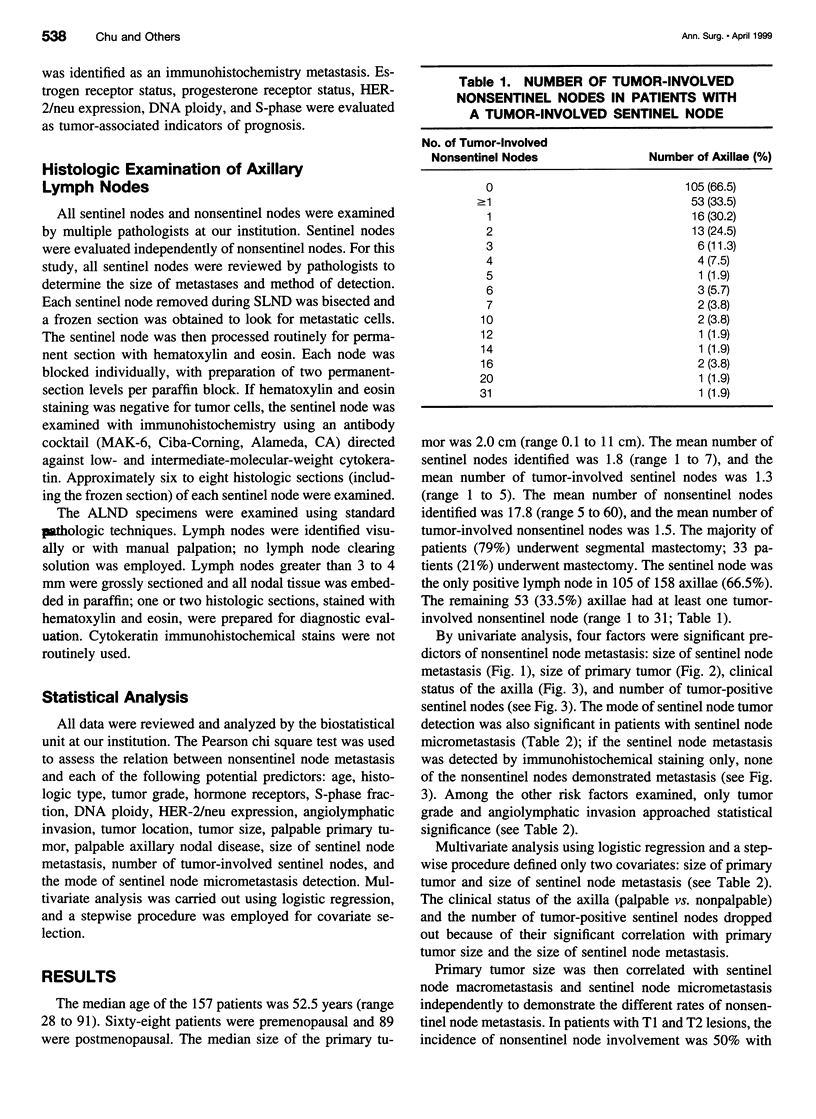
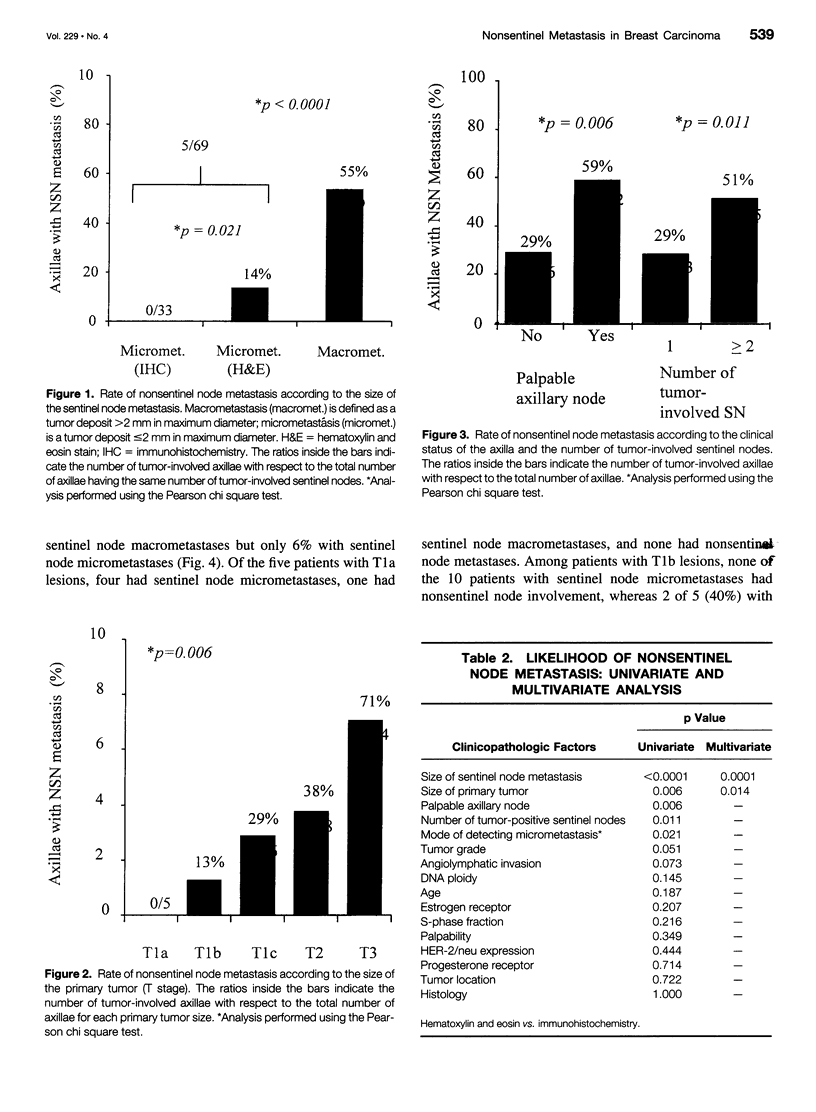
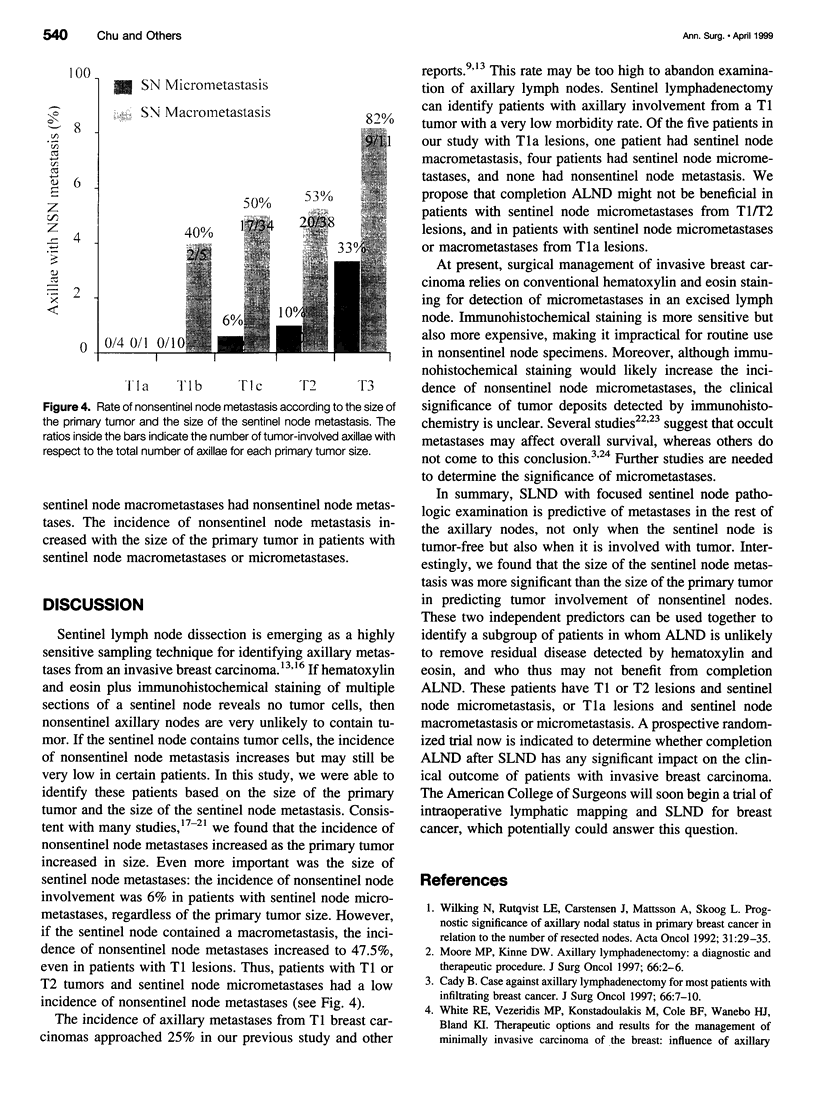
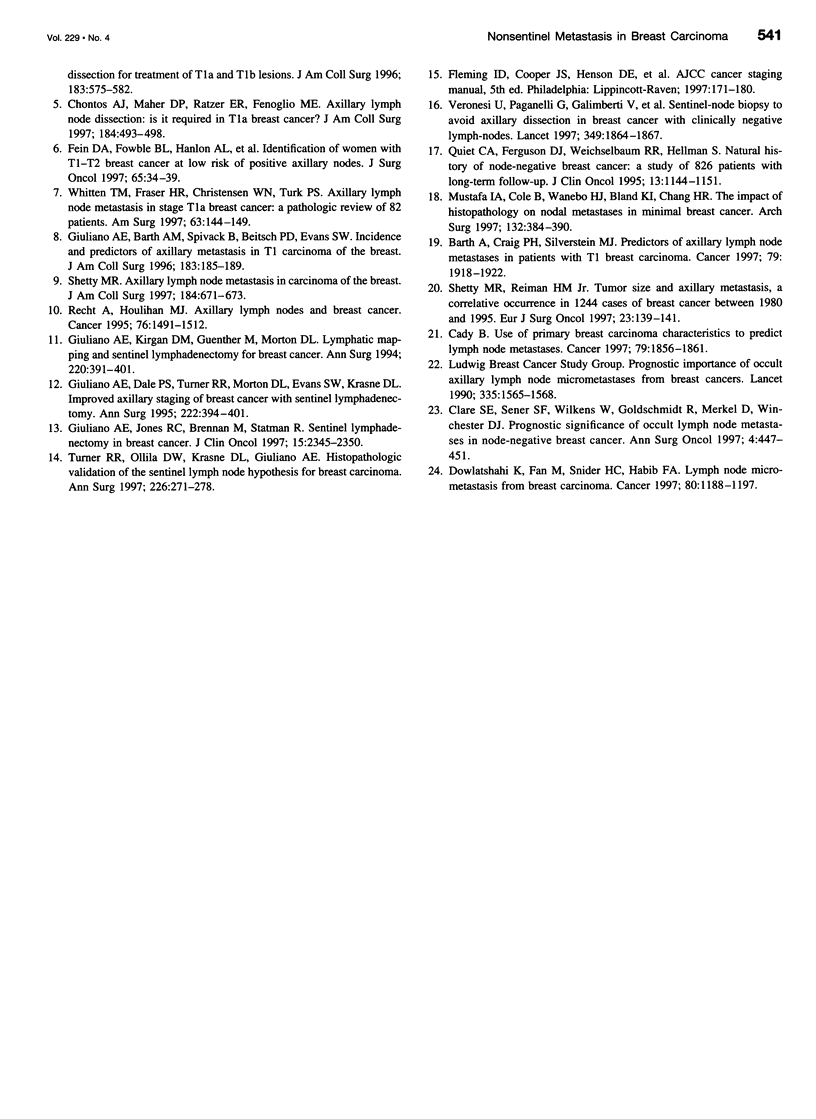
Selected References
These references are in PubMed. This may not be the complete list of references from this article.
- Barth A., Craig P. H., Silverstein M. J. Predictors of axillary lymph node metastases in patients with T1 breast carcinoma. Cancer. 1997 May 15;79(10):1918–1922. [PubMed] [Google Scholar]
- Cady B. Case against axillary lymphadenectomy for most patients with infiltrating breast cancer. J Surg Oncol. 1997 Sep;66(1):7–10. doi: 10.1002/(sici)1096-9098(199709)66:1<7::aid-jso3>3.0.co;2-8. [DOI] [PubMed] [Google Scholar]
- Cady B. Use of primary breast carcinoma characteristics to predict lymph node metastases. Cancer. 1997 May 15;79(10):1856–1864. doi: 10.1002/(sici)1097-0142(19970515)79:10<1856::aid-cncr2>3.0.co;2-e. [DOI] [PubMed] [Google Scholar]
- Chontos A. J., Maher D. P., Ratzer E. R., Fenoglio M. E. Axillary lymph node dissection: is it required in T1a breast cancer? J Am Coll Surg. 1997 May;184(5):493–498. [PubMed] [Google Scholar]
- Clare S. E., Sener S. F., Wilkens W., Goldschmidt R., Merkel D., Winchester D. J. Prognostic significance of occult lymph node metastases in node-negative breast cancer. Ann Surg Oncol. 1997 Sep;4(6):447–451. doi: 10.1007/BF02303667. [DOI] [PubMed] [Google Scholar]
- Dowlatshahi K., Fan M., Snider H. C., Habib F. A. Lymph node micrometastases from breast carcinoma: reviewing the dilemma. Cancer. 1997 Oct 1;80(7):1188–1197. doi: 10.1002/(sici)1097-0142(19971001)80:7<1188::aid-cncr2>3.0.co;2-h. [DOI] [PubMed] [Google Scholar]
- Fein D. A., Fowble B. L., Hanlon A. L., Hooks M. A., Hoffman J. P., Sigurdson E. R., Jardines L. A., Eisenberg B. L. Identification of women with T1-T2 breast cancer at low risk of positive axillary nodes. J Surg Oncol. 1997 May;65(1):34–39. doi: 10.1002/(sici)1096-9098(199705)65:1<34::aid-jso7>3.0.co;2-p. [DOI] [PubMed] [Google Scholar]
- Giuliano A. E., Barth A. M., Spivack B., Beitsch P. D., Evans S. W. Incidence and predictors of axillary metastasis in T1 carcinoma of the breast. J Am Coll Surg. 1996 Sep;183(3):185–189. [PubMed] [Google Scholar]
- Giuliano A. E., Dale P. S., Turner R. R., Morton D. L., Evans S. W., Krasne D. L. Improved axillary staging of breast cancer with sentinel lymphadenectomy. Ann Surg. 1995 Sep;222(3):394–401. doi: 10.1097/00000658-199509000-00016. [DOI] [PMC free article] [PubMed] [Google Scholar]
- Giuliano A. E., Jones R. C., Brennan M., Statman R. Sentinel lymphadenectomy in breast cancer. J Clin Oncol. 1997 Jun;15(6):2345–2350. doi: 10.1200/JCO.1997.15.6.2345. [DOI] [PubMed] [Google Scholar]
- Giuliano A. E., Kirgan D. M., Guenther J. M., Morton D. L. Lymphatic mapping and sentinel lymphadenectomy for breast cancer. Ann Surg. 1994 Sep;220(3):391–401. doi: 10.1097/00000658-199409000-00015. [DOI] [PMC free article] [PubMed] [Google Scholar]
- Moore M. P., Kinne D. W. Axillary lymphadenectomy: a diagnostic and therapeutic procedure. J Surg Oncol. 1997 Sep;66(1):2–6. doi: 10.1002/(sici)1096-9098(199709)66:1<2::aid-jso2>3.0.co;2-8. [DOI] [PubMed] [Google Scholar]
- Mustafa I. A., Cole B., Wanebo H. J., Bland K. I., Chang H. R. The impact of histopathology on nodal metastases in minimal breast cancer. Arch Surg. 1997 Apr;132(4):384–391. doi: 10.1001/archsurg.1997.01430280058008. [DOI] [PubMed] [Google Scholar]
- Quiet C. A., Ferguson D. J., Weichselbaum R. R., Hellman S. Natural history of node-negative breast cancer: a study of 826 patients with long-term follow-up. J Clin Oncol. 1995 May;13(5):1144–1151. doi: 10.1200/JCO.1995.13.5.1144. [DOI] [PubMed] [Google Scholar]
- Recht A., Houlihan M. J. Axillary lymph nodes and breast cancer: a review. Cancer. 1995 Nov 1;76(9):1491–1512. doi: 10.1002/1097-0142(19951101)76:9<1491::aid-cncr2820760902>3.0.co;2-8. [DOI] [PubMed] [Google Scholar]
- Shetty M. R. Axillary lymph node metastasis in carcinoma of the breast. J Am Coll Surg. 1997 Jun;184(6):671–673. [PubMed] [Google Scholar]
- Shetty M. R., Reiman H. M., Jr Tumor size and axillary metastasis, a correlative occurrence in 1244 cases of breast cancer between 1980 and 1995. Eur J Surg Oncol. 1997 Apr;23(2):139–141. doi: 10.1016/s0748-7983(97)80007-8. [DOI] [PubMed] [Google Scholar]
- Turner R. R., Ollila D. W., Krasne D. L., Giuliano A. E. Histopathologic validation of the sentinel lymph node hypothesis for breast carcinoma. Ann Surg. 1997 Sep;226(3):271–278. doi: 10.1097/00000658-199709000-00006. [DOI] [PMC free article] [PubMed] [Google Scholar]
- Veronesi U., Paganelli G., Galimberti V., Viale G., Zurrida S., Bedoni M., Costa A., de Cicco C., Geraghty J. G., Luini A. Sentinel-node biopsy to avoid axillary dissection in breast cancer with clinically negative lymph-nodes. Lancet. 1997 Jun 28;349(9069):1864–1867. doi: 10.1016/S0140-6736(97)01004-0. [DOI] [PubMed] [Google Scholar]
- White R. E., Vezeridis M. P., Konstadoulakis M., Cole B. F., Wanebo H. J., Bland K. I. Therapeutic options and results for the management of minimally invasive carcinoma of the breast: influence of axillary dissection for treatment of T1a and T1b lesions. J Am Coll Surg. 1996 Dec;183(6):575–582. [PubMed] [Google Scholar]
- Whitten T. M., Fraser H. R., Christensen W. N., Turk P. S. Axillary lymph node metastasis in stage T1a breast cancer: a pathologic review of 82 patients. Am Surg. 1997 Feb;63(2):144–149. [PubMed] [Google Scholar]
- Wilking N., Rutqvist L. E., Carstensen J., Mattsson A., Skoog L. Prognostic significance of axillary nodal status in primary breast cancer in relation to the number of resected nodes. Stockholm Breast Cancer Study Group. Acta Oncol. 1992;31(1):29–35. doi: 10.3109/02841869209088261. [DOI] [PubMed] [Google Scholar]


